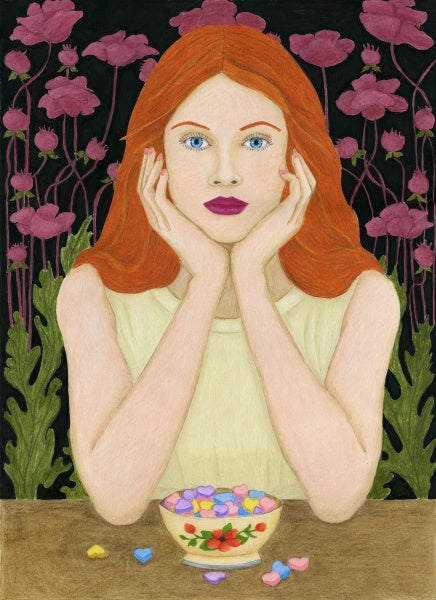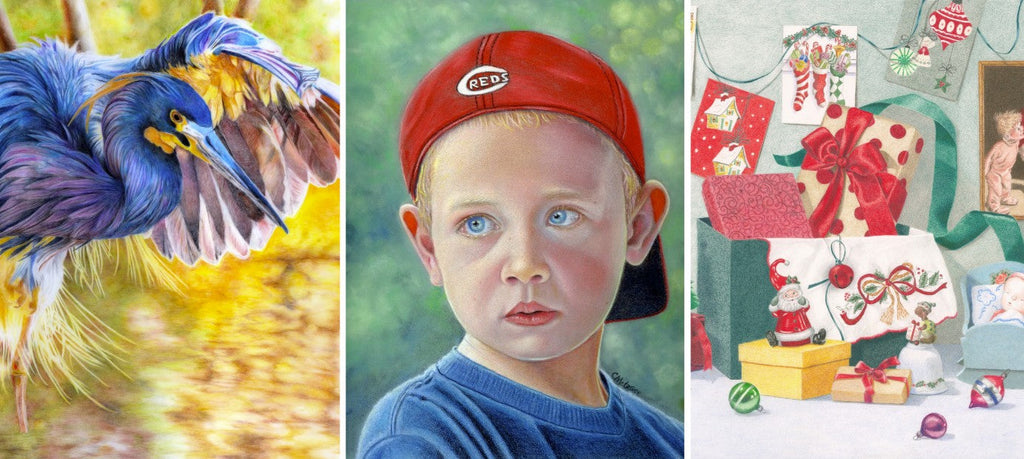Using Slice Blade For Highlights and Fur
by Caroline Arnott
I will outline the process of drawing a realistic wolf ear using coloured pencils. I will mention the various techniques and tools used to create fur highlights and intricate overlapping sections, ultimately enhancing the illusion of realism in a wildlife portrait.
Applying the Base layers of pencil and loosely mapping out the areas of high contrast and shadow, this will be the building ground of the following layers.
ESTABLISHING THE COLOUR LAYERS
To begin the wolf ear, I start by applying a light base layer using a Caran D’Ache Luminance pencil (Titanium White). This reduces the tooth of the paper, providing a smooth base to start building the next colour layers.
Working from light to dark, I build up layers of colour to map out the fur texture, direction of growth and the shadows and highlights of the ear. The initial light base colours consist of a combination of cool and warm greys, pastel blues, pinks, and ochres. Throughout this early stage I will keep checking my reference photo, my goal is not to replicate the reference exactly, but instead use my artistic interpretation to enhance and build on the details that are interesting to me, such as the intricate cross-over hairs and different colour layers.
In these early stages, I approach the drawing as a collection of abstract shapes and shadows, highlights and contrast, rather than focusing solely on trying to achieve a realistic fur texture immediacy. This method allows me to gradually build colour and depth in layers, without getting too overwhelmed by trying to make the fur look realistic straight away.
ADDING HIGHLIGHTS AND CROSS-OVER FUR
The next step is to introduce highlights and overlapping fur, enhancing the sense of realism. Over the years, I have experimented with several techniques to achieve these effects. Some methods include negative space shading, where I outline the lighter areas of fur using darker tones, and the use of an indenting tool, which creates recessed areas in the paper that remain white even when layered over with colour. For lighter cross over strands of fur, I use the Caran D’Ache Luminance white pencil. This pencil is highly pigmented, producing clean, bright white lines even over darker layers.
Using the Slice Ceramic Blade Tool I gently scrape away layers of pigment to leave a highlight, using varying pressure on how vibrant I want the highlight to appear.
Once the ear has reached a certain level of detail, I use the Slice ceramic blade tool to create additional cross-over fur strands. It is important that enough colour layers are applied before using this tool, as it scrapes away pigment to create the highlight. I prefer a rounded ceramic blade to avoid damaging the paper, ensuring only a light removal of pigment. To use the blade, I will carefully scrape a layer of pigment away, using varying pressure depending on how vibrant I want the highlight to appear.
After the highlights are in place, I blend them back into the portrait using coloured pencils. I also enhance the highlights by adding contrasting darker tones around them to really make them pop.
The primary advantage of using the Slice Ceramic Blade tool in wildlife drawings is its ability to enhance the illusion of realism. By adding stray hairs and subtle highlights, it effectively breaks up patterns in the fur, drawing the viewer's attention to intricate details. This technique helps create a more dynamic and lifelike representation, making the artwork more engaging and visually captivating.
As the ear begins to take shape and appear more lifelike, I continue refining the details by adding additional highlights and layers of contrast. I will usually take a break and revisit the portrait with fresh eyes later, which allows me to make any final adjustments and add the finishing touches.
The finished portrait of the two wolves, I have a full timelapse tutorial available on my YouTube Channel Carolinearnottart
MATERIALS USED
Faber-Castell Polychromos and Caran d'Ache Luminance colour pencils
Slice Ceramic blade tool
Fabriano Artistico HP watercolour paper 300gsm
Reference Photo - Emmanuel Keller @ Wildlife Reference Photos
CAROLINE ARNOTT:
Caroline is a self-taught artist based in East Yorkshire, UK, with over fifteen years of experience specializing in highly detailed, realistic portraits of pets and wildlife. Working primarily with coloured and graphite pencils, Caroline captures the intricate beauty of her subjects with precision and depth. Her dedication to realism, combined with a passion for the natural world, is reflected in every piece she creates.
www.carolinearnottart.co.uk




